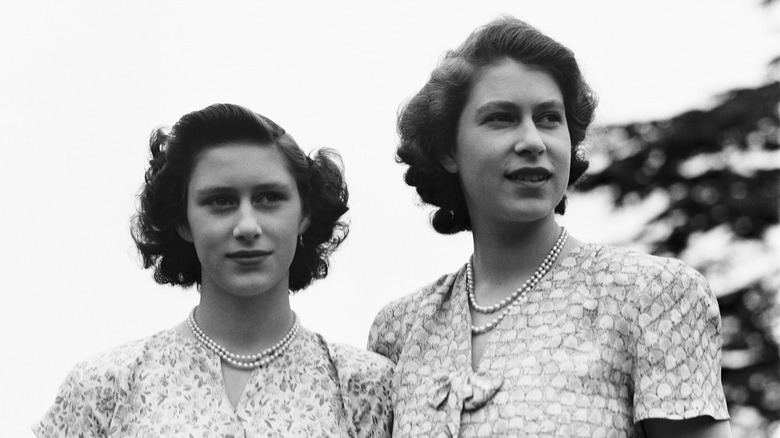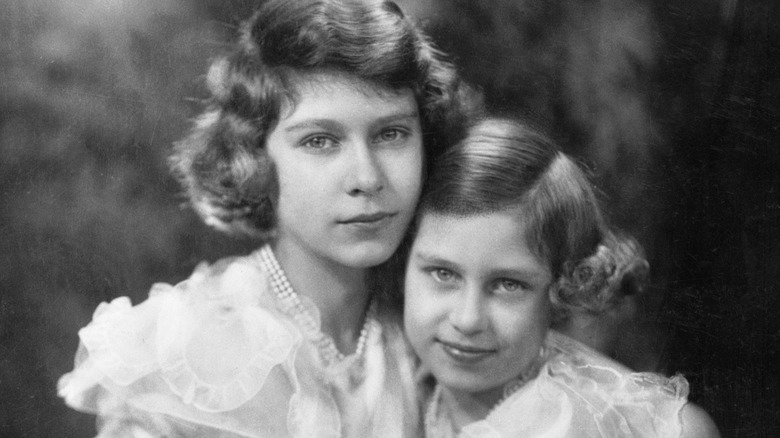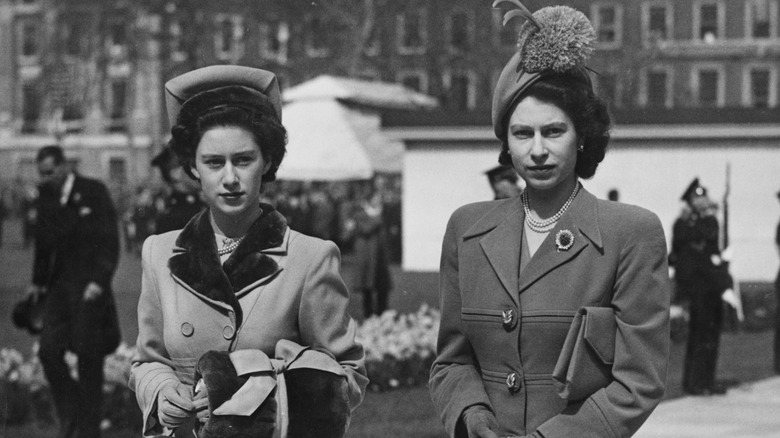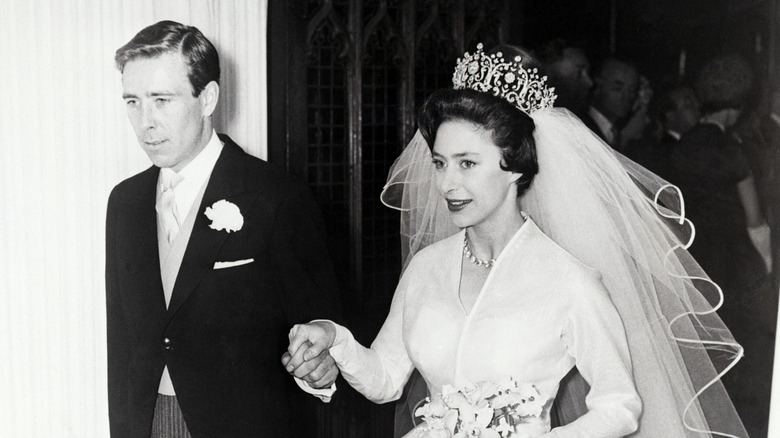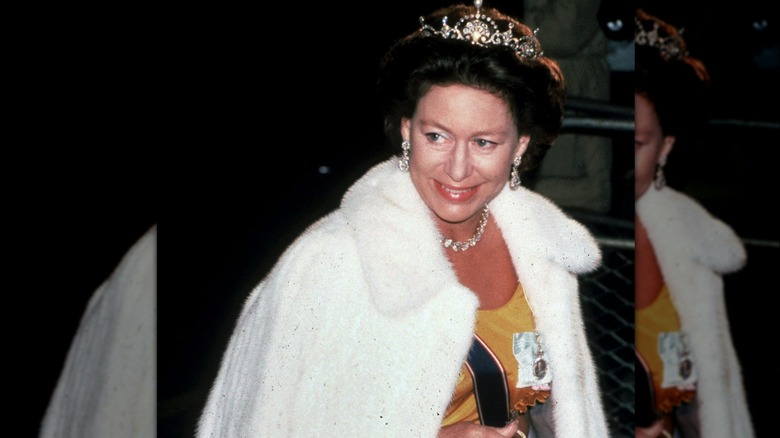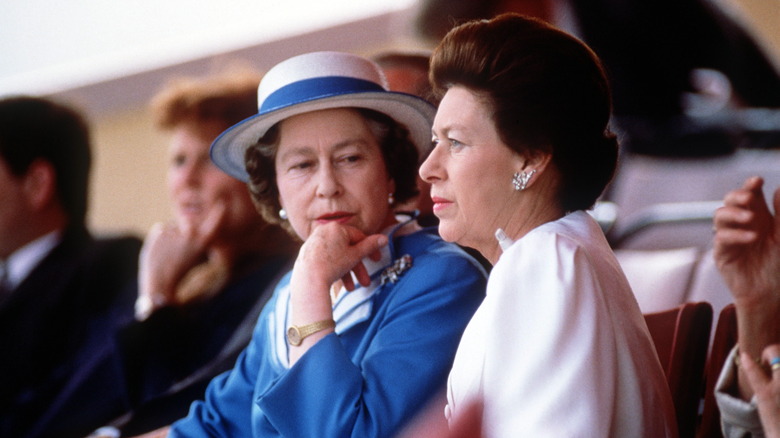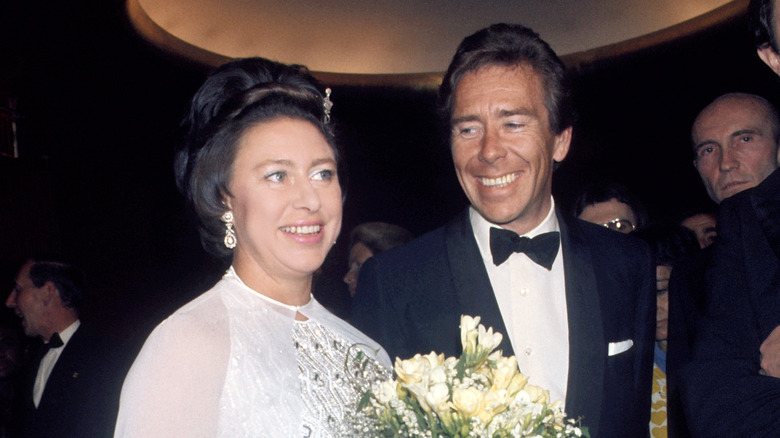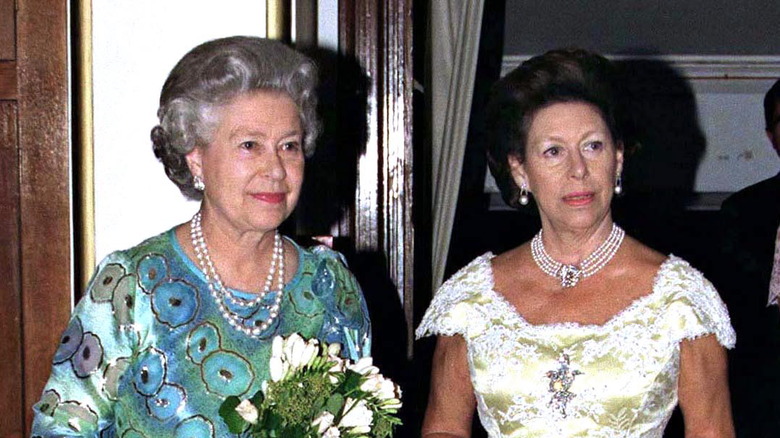Princess Margaret Was Never The Same After Elizabeth Became Queen
The late Queen Elizabeth II became queen on February 6, 1952, while she was abroad in Kenya. She returned to England and assumed the position of queen at age 25. It marked an abrupt end to Elizabeth's more low-key life as a princess. She and her husband, Prince Philip, were stationed in Malta during the early years of their marriage because of his naval career. The story goes that they were both loathing to end that chapter of their lives so soon, but Elizabeth had to honor her obligations. While much has been made of the shift for Elizabeth and Philip — not to mention the rigorous demands put upon them by royal life — it's easier to forget that Princess Margaret was impacted by this change too.
The princess, who was 22 when Elizabeth became queen, had a rocky adjustment to her sister's role as sovereign. It thrust Margaret into an extremely public role, as it did for Elizabeth, and neither sister asked for such intense publicity. Because of Margaret's sudden notoriety as the sister to the queen, her natural proclivity for excess and hedonism was that much more noticeable to people. She was heavily criticized, and many lifestyle choices were restricted because of her adjacency to the throne. She was also cast aside often because her sister was the monarch, leaving her firmly in Elizabeth's wake. While it's tough to feel sorry for a princess, Margaret had a tragic life. Much of this upheaval and difficulty came because of Elizabeth's prominent, public role.
Margaret became spoiled and her education suffered
Like most aristocratic children in England at the time, Princesses Elizabeth and Margaret were educated at home, in a pedagogy that was given by governesses and their mother. In fact, the sisters were raised to be almost twins, even though they were four years apart. Things in their lives took a shocking twist in 1936, when her uncle, King Edward VIII, abdicated the throne, making her father King George VI. Elizabeth was only ten when she found out that she would be queen. Allegedly, to make up for the fact that Margaret wouldn't be queen, she was notably spoiled by her parents.
She also wasn't educated as rigorously as her sister. While the two had been previously educated equally, things shifted the moment that Elizabeth found out that she was heir to the throne. Margaret's education suffered and she was kept behind so that Elizabeth could thrive. In the BBC's documentary "Princess Margaret: The Rebel Royal," Lady Anne Glenconner explained that Margaret felt that her education changed once it was clear that Elizabeth would be queen. "[Princess Margaret] always said, 'I was never educated as well as my sister in order not to be a sort of threat to her,' that's what she felt," Lady Anne said. While the threat element of that quote is debatable, there is truth to the fact that Elizabeth was educated differently. She had tutors from Oxford University and Eton College, while Margaret continued to be taught by governesses.
Queen Elizabeth's monarchy made Princess Margaret jealous
By all accounts, Queen Elizabeth II and Princess Margaret were close all of their lives. For them, there was no shaking the sisterly bond. However, that didn't mean that Margaret felt left behind by her sister's prominent role and in turn, Margaret became jealous of Elizabeth's role as monarch. Since Margaret was so outgoing and socially dazzling, she felt that she would have done the job better. By contrast, Elizabeth could be much more reserved. Not only that, it was Elizabeth's marriage to Prince Philip and her family that also caused these feelings in Margaret. She had such a difficult romantic life, considering the fact that the Royal Marriages Act prohibited her from marrying the divorced Captain Peter Townsend. Elizabeth had been able to marry the man she loved, but Margaret couldn't. This certainly didn't ease up the tension between the sisters.
A royal correspondent called Margaret's feelings a "[subconscious] jealousy" in The Telegraph. While she often kept her feelings hidden, she did occasionally slip into passive aggressive behavior to let Elizabeth know how she felt. Margaret famously missed her sister's 10th wedding anniversary party at Buckingham Palace on November 20, 1957. After a night of placing herself in very public locations — she went to a party at the Coliseum and later had dinner at the Savoy — Margaret stopped by the party at midnight. She left an hour later. Obviously, this was a very public display of frustration towards her sister's glittering life.
She had to begin a life of public engagements early on
After the groundbreaking news that Prince Harry and Meghan Markle aired that they were stepping down as senior royals, younger royal fans suddenly got a better understanding of what it means to be a working royal. The list of working royals suddenly became a topic of much interest and Princess Anne seems to unilaterally top everyone else for the most duties performed every year.
Well, long before contemporary royals showed their interest in working on the monarch's behalf, Princess Margaret was tasked with the role of being a working royal. With her sister as queen, Margaret had to step into a public role. As the royal family's official website notes, Margaret took on engagements and duties when she was still very young. Duties only increased with time. In fact, the website notes that over her lifetime, Margaret was either the patron or the president of over 80 organizations. She was frequently called upon to represent Queen Elizabeth II at events and on royal tours. In 1955, when she was 25, Margaret went to the Caribbean for her first solo Commonwealth visit.
Fans of Netflix's "The Crown" will recall the fictionalized portrayal of Margaret's tour of the United States and her visit with then-President Lyndon B. Johnson in 1965. She was there on behalf of Her Majesty's Government to secure a loan from the U.S. for the United Kingdom, which she was able to do.
Her romantic relationships were under a different level of scrutiny
Princess Diana wasn't the first royal in recent memory to face scrutiny for her failed marriage to the then-Prince Charles. Long before that divorce went through, Princess Margaret was making separation headlines of her own. From the get-go, Margaret was hemmed in romantically because of her role as princess and sister to Queen Elizabeth II. As such a public person, she didn't have the freedom to move in and out of relationships as she needed to or wished. This was initially evident in the thwarted love between her and Group Captain Peter Townsend.
Her marriage to Antony Armstrong-Jones was the talk of England. Theirs was the first televised royal marriage, and Armstrong-Jones was the first commoner in 400 years to marry a royal. It was major news. Later, after her marriage to Armstrong-Jones failed, her 1978 divorce became a scandal. While Margaret never remarried, she did have another relationship that became a scandal of its own. She dated Roddy Llewellyn, who was 17 years younger than the princess. The press had an absolute field day over the relationship, and hounded the couple. "When it emerged that Margaret was having the relationship with Roddy Llewellyn, we were absolutely in the age of tabloid gossip and celebrity news and this was the perfect story was to feed that machine," Chris Granlund, who was the executive producer of "Margaret: A Rebel Princess" said, per Town & Country. The two dated for eight years.
Her lavish lifestyle was heavily criticized by the public
Because of her role as a public figure, which came largely because her sister was Queen Elizabeth II, Princess Margaret was heavily criticized throughout her life for her excessive spending. She was famously much more hedonistic than her tempered sister, and Margaret's lifestyle was often a topic in the media, creating news fodder for the press. She was known as a "party princess," and that reputation followed her for her entire adult life. Her morning routine, according to Craig Brown's book "Ma'am Darling," consisted of breakfast in bed at 9:00 a.m. followed by endless cigarettes and two hours of listening to the radio. At 12:30, she started drinking vodka.
Her honeymoon with Antony Armstrong-Jones, which took place in 1960 aboard the royal yacht Britannia, cost $115,000 and lasted for six weeks. Her visit to the United States in 1965 was a success in that she was able to secure a financial bailout for Great Britain, but she was simultaneously criticized for how lavish her trip was. The trip cost £30,000, an amount that was deemed excessive by the British public, and because of this, she was actually banned from a later trip to the U.S., which was slated to take place in the 1970s. When she was able to visit the United States again in 1995, she brought $10,000 worth of clothing with her for a one week trip. The public often expressed concern over such excesses.
Her relationship with her sister changed
Princess Margaret's relationship with Queen Elizabeth II changed when the latter became queen, and like all sibling relationships, theirs was a complex one. For one, Margaret became Elizabeth's subject, a tough transition for any little sister. While Margaret could be jealous and vindictive about their different roles and Elizabeth's power, she was also deeply respectful of her sister. According to royal correspondent Reinaldo Herrera in Vanity Fair, Margaret only called Elizabeth "The Queen" when she was in public. Behind closed doors, she called her by her famous nickname, Lilibet.
While Margaret wasn't shy to state her feelings to anyone, she was also deeply concerned about displeasing her sister. As Craig Brown, author of "Ninety-Nine Glimpses of Princess Margaret" explained (via New York Post), Margaret had a fear her whole life that her sister might be angry with her and "could not rest until she heard her sister's voice in waking life." She'd call on her direct line to Buckingham Palace every morning, and Margaret could get the reassurance she needed that Elizabeth wasn't upset with her over one of her recent antics. "They would then hang up, and the day could proceed without the black cloud of [Margaret] being 'in disgrace,'" Brown explained.
When Margaret died in February 2002, Queen Elizabeth lost her closest friend. At her funeral at St. George's Chapel at Windsor Castle, Herrera notes that it was one of the few moments when the world saw the queen display grief publicly.
Princess Margaret's divorce shocked the public
While Princess Margaret had the eyes of the world on her during all of her romantic relationships, it was her marriage and subsequent divorce from Antony Armstrong-Jones that caused a big ruckus not only for the princess but the whole royal family. Margaret and Armstrong-Jones married in 1960 and welcomed two children: David Armstrong-Jones and Lady Sarah Chatto. When they were together, Margaret and Armstrong-Jones were the talk of the town. "During the 60s, before their marriage started going wrong, they were royalty's golden couple," royal biographer Christopher Warwick said to People. "Stories about them were legion, with their star-studded parties at Kensington Palace. If you were being invited by them you were being invited to breathe in rarified air."
However, things turned sideways for the couple, with both of them having affairs during their marriage. Their divorce, which was finalized in July 1978, was historical. A senior royal couple hadn't ended a marriage since 1540, when King Henry VIII had his marriage to Anne of Cleves annulled. Divorce was uncommon in the royal family, making Margaret's shock to the public. The scandal was doubly compounded when news broke that Margaret had been having an affair with the much younger Roddy Llewellyn. Margaret's divorce also changed the nature of marriage for future royals. "She did tarnish the family's reputation but she cleared the way for others to get out of unhappy marriages," correspondent Jennie Bond said in "Princess Margaret: A Rebel Without a Crown."
Her rudeness was well documented, in contrast to her sister's politeness
Queen Elizabeth II was famously gracious, kind, and polite throughout her record-breaking reign. This was part of what made her so admirable to her subjects, and upon her death, a mourner noted to The Washington Post: "She was very welcoming even to leaders that most would say wouldn't deserve it. She showed complete grace and decorum to whomever she met."
This was not always the case for Princess Margaret. Even when speaking to the Queen Mother, Margaret could be extraordinarily rude. The mother-and-daughter duo famously bickered, with Margaret saying things like, "Why do you dress in those ridiculous clothes?" (via Vanity Fair). Royal staff dreaded her presence, especially those at Clarence House, who had served Margaret for a long time. When Margaret moved out of the house on her wedding day, the comptroller of the house, Lord Adam Gordon said, "Good-bye, Your Royal Highness," and when she was out of earshot, he added, "and we hope forever."
The model Twiggy recalled her encounter with Margaret at a dinner party. "Prince Margaret asked, 'What's your name?'" Twiggy explained, per Express. "I said, 'My name's Lesley Hornby, Ma'am, but everyone calls me Twiggy.' She just looked at me and said (that accent again) 'Oh, how unfortunate'. Then she didn't talk to me again. I was mortified." Margaret once criticized Elizabeth Taylor's famous Krupp diamond ring, a gift from Richard Burton, to the actor's face. "Is that the famous diamond?" Margaret asked (via Express). "It's so large! How very vulgar!" That sounds like Princess Margaret!
